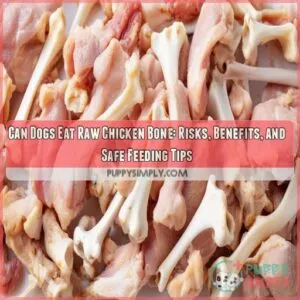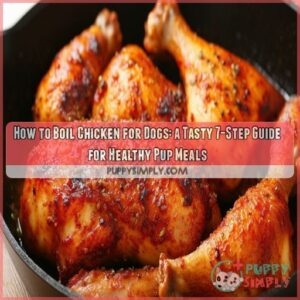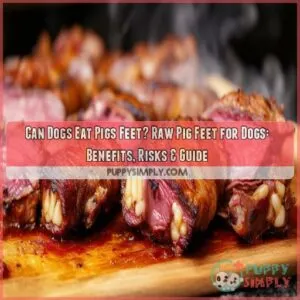This site is supported by our readers. We may earn a commission, at no cost to you, if you purchase through links.
 Do you ever worry about what kinds of bones are safe for your pup? If so, you’re not alone. With the rise in popularity of raw diets, many pet owners wonder if it is okay to give their dogs chicken leg bones and other types of poultry parts.
Do you ever worry about what kinds of bones are safe for your pup? If so, you’re not alone. With the rise in popularity of raw diets, many pet owners wonder if it is okay to give their dogs chicken leg bones and other types of poultry parts.
The answer can be complicated; some forms of poultry may be beneficial while others pose a risk to your pup’s health.
In this article, we’ll go over everything you need to know about canines eating chicken legs and other related items such as eggs or feet – both cooked and raw! We’ll discuss any potential risks along with benefits that could arise from feeding these foods to our furry friends.
So grab a snack for yourself (but keep Fido away!) and let’s delve into whether or not dogs can eat chicken legs!
Table Of Contents
- Key Takeaways
- Can Dogs Eat Chicken Legs?
- What Happens if a Dog Eats Raw Chicken?
- Is Raw Chicken Safe for Dogs?
- Is Raw Chicken Good for Dogs?
- Can Dogs Eat Raw Chicken Bones?
- Can Dogs Eat Raw Chicken Eggs?
- Benefits of Chicken Feet for Dogs
- Where to Buy Chicken Feet for Dogs?
- How Many Chicken Feet Should I Give to My Dog?
- Should Dogs Eat Chicken Leg Meat?
- Frequently Asked Questions (FAQs)
- Conclusion
Key Takeaways
- Raw chicken legs provide protein and nutrients.
- Small dogs should avoid bones due to the choking hazard.
- Cooked chicken legs can cause pancreatitis.
- Chicken feet improve joint health and remove tartar from teeth.
Can Dogs Eat Chicken Legs?
You can safely give your pup raw chicken legs as part of a balanced diet, but make sure to supervise them while they chew. Raw chicken legs are meaty bones that provide bone in addition to the protein and nutrients dogs need.
Plus, these bones contain glucosamine and chondroitin, which both promote joint health for your dog.
If you feed only one or two pieces of raw meaty bones at any given time, this should be enough for most pups without overfeeding or leading them into an unhealthy diet. Keep in mind that some smaller breeds may not tolerate whole raw bones due to their size, so consult with a vet if you have concerns about feeding larger chicken parts to small breed dogs.
In addition, it’s important not to give cooked chicken leg bones because high heat makes them dangerous – always opt for providing fresh or dried uncooked versions instead! As long as you practice moderation when introducing new foods like these into your pup’s meals, balance is key!
What Happens if a Dog Eats Raw Chicken?
Feeding your pup raw chicken can provide them with protein, nutrients, and natural sources of glucosamine and chondroitin to support joint health. However, it is important to be aware that up to 10% of dogs may experience digestive upset or allergies after eating raw chicken.
Raw chicken legs are a safe meaty bone for chewing, but make sure to supervise your dog while they are doing so! Raw meat should form the bulk of their meal, supplemented by organ meats like liver (no more than 5%), as well as muscle meats such as thighs for additional nutrition.
It’s also important not to feed too much raw egg whites due to the biotin inhibitor present in these foods. Lastly, you’ll want to avoid fried or greasy poultry dishes, as they could cause pancreatitis in your pooch.
By following these guidelines when feeding your furry friend some delicious cooked/raw chicken legs, you can have peace of mind knowing they’re getting all the essential vitamins and minerals required for a healthy fur-ever life!
Is Raw Chicken Safe for Dogs?
Raw chicken is a natural and nutritious treat for your pup, providing vital proteins, minerals, and vitamins to keep them healthy – just make sure it’s given in moderation.
Raw chicken legs are an excellent source of protein that can be enjoyed as part of a balanced raw diet.
- Raw chicken thighs provide bone.
- Raw chicken necks are meaty bones ideal for snacks.
- Chicken feet have health benefits due to their glucosamine content, which helps support joint health.
- Lean cooked breast makes great treats, but avoid skin or fat.
Always supervise when giving any chews or bones, and never feed cooked ones as they can splinter dangerously.
Limit raw egg whites due to the biotin inhibitor found in the white, while also limiting raw skins due to higher fat content than leaner cuts.
Still, make sure livers form no more than 5% of the diet too since they’re rich in iron, which should only be consumed sparingly by dogs with sensitive stomachs.
Finally, always ensure there’s fresh water available at all times while serving up these tasty morsels!
Is Raw Chicken Good for Dogs?
When it comes to your pup, raw chicken can be an excellent part of a balanced diet! The meat from chicken legs is high in protein and other essential nutrients, while ground bone provides calcium for strong bones.
Raw egg whites are also great as they contain biotin, which supports healthy skin and coat. Additionally, raw chicken feet provide important joint support due to their glucosamine and chondroitin content.
Finally, it’s best to limit small amounts of liver in the mix as this organ has higher levels of fat than other proteins.
It’s important when adding any new food or treat into your pet’s diet that you practice moderation and variety – too much could lead them to feel sick or lethargic! Supervising meals with chews like raw chicken feet is always a good idea so you make sure things stay safe (think no choking hazards).
Raw chickens may not be suitable for all dogs: puppies shouldn’t have large pieces that can block their throat; smaller breeds should avoid bones altogether; those prone to pancreatitis should steer clear of greasy treats entirely; older dogs will benefit more from softer chewable snacks instead anyway – just keep these guidelines in mind before indulging them with anything new at mealtimes!
Can Dogs Eat Raw Chicken Bones?
You can give your pup raw chicken bones as a chew treat, but be sure to supervise them while they’re chewing and discard any small pieces that break off. Raw or dehydrated chicken feet are an excellent source of glucosamine and chondroitin, which support joint health and mobility.
Here’s what you need to know when feeding your dog raw or cooked chicken bones:
- Only feed uncooked bone; cooked poultry bones splinter easily
- Avoid giving small dogs large chunks of bone due to potential choking hazard
- Stick with larger leg bones for supervised chews on occasion
- If sourcing from grocery store chickens, make sure the meat is fresh
Limit how much fat is given (especially in skin) as this may lead to pancreatitis.
Raw diets provide essential nutrients, including protein, which are beneficial for overall canine health. However, it’s important not to overdo it by providing only lean cuts like breast meat along with some organ meats such as livers every now and then in moderation.
Can Dogs Eat Raw Chicken Eggs?
Raw chicken eggs can provide your pup with a protein boost, as well as glucosamine and chondroitin for joint support. But can dogs eat raw chicken eggs? The answer is yes – all dogs, even puppies, should be able to consume small amounts of raw egg without any problems.
However, it’s important that they’re included in a complete and balanced diet so the nutrients are absorbed properly.
Raw egg whites contain an enzyme called avidin, which blocks biotin absorption. So, too much could cause deficiencies over time if not supplemented correctly. It’s also important to make sure the shells are completely broken down before feeding them to your dog since they contain calcium carbonate, which could be dangerous if swallowed whole or chewed into large pieces.
Overall, though, adding some raw eggs into their diet every now and again provides great nutritional value!
Benefits of Chicken Feet for Dogs
Research shows that chicken feet can be beneficial to your dog’s health. They are a natural source of glucosamine and chondroitin, which help improve joint health and mobility, as well as support arthritis prevention.
Additionally, the collagen found in these bones helps keep teeth clean by removing plaque and tartar buildup with regular chewing.
Arthritis, Joint Health and Mobility of Dogs
Chicken feet are a great way to support joint and mobility health for your furry friend as they contain natural sources of glucosamine and chondroitin. Raw chicken bones can also be beneficial, providing lean meat with bone on the side.
Including frozen chicken legs in a balanced raw diet is another way to provide an excellent source of protein while also supplying vital nutrients such as calcium, phosphorus, and glucosamine that help joints stay healthy and mobile.
For additional benefits related to joint health, look no further than adding some cooked (but not fried) skinless, boneless chicken meat into your dog’s meal plan. It provides much-needed lean proteins without any fat or seasonings that could cause digestive issues later on.
However, it’s important to practice moderation when introducing new food items or chews.
Dental Health of Dogs
Chewing chicken feet can help keep your pup’s teeth pearly white, with the glucosamine and chondroitin providing a natural form of plaque and tartar removal – like giving your dog their own toothbrush!
Chicken leg bones contain finely ground bone, making them easier to digest than cooked or raw ones. This helps remove food particles from between their gums and teeth, reducing plaque buildup.
Glucosamine, in particular, has been linked to reducing inflammation around the mouth area, which can lead to gum recession over time.
The health benefits of chicken feet go beyond just dental hygiene. They also provide essential vitamins and minerals, such as calcium, that are necessary for proper joint function in growing puppies too.
With regular chewing on this tasty treat, you’ll be sure that your furry companion is getting all the nutrition they need for optimal oral health and overall well-being!
Where to Buy Chicken Feet for Dogs?
When it comes to feeding your pup raw chicken feet, you may be wondering where to buy them. Chicken feet are a great source of nutrients for dogs and can help support joint health. They also make an excellent natural dental chew that helps remove plaque and tartar build-up from their teeth.
Fortunately, these days it’s easier than ever to find a good quality source of chicken feet for your furry friend!
First off, many pet stores will carry frozen or freeze-dried raw chicken feet specifically marketed for dogs as part of a balanced diet plan, including other types of bones like beef knuckles or turkey necks.
You can also purchase online from various retailers who specialize in canine nutrition products, such as NaturesMenuUSA or RawBistroPetFoods. Both offer high-quality options with free delivery services available depending on the size/quantity purchased.
Additionally, local farmers markets often have live chickens which come with their own set of edible appendages – just remember not to feed cooked poultry products because they could splinter when chewed by animals!
Finally, if all else fails, there is always the option of getting them directly from butchers near you – although this route might require more effort upfront due to the much greater availability over internet sources mentioned above.
Regardless of what method works best for you though (or how hard finding these little critters becomes), one thing remains true: providing nutritional variety through naturally sourced treats like raw chicken legs is an important part of maintaining overall health and wellness in our four-legged friends, so don’t forget about giving them some love too every now and then!
How Many Chicken Feet Should I Give to My Dog?
You should give your pup 1-3 chicken feet daily, depending on their diet and size, to reap the health benefits of glucosamine and chondroitin for joint mobility. Chicken feet are a great natural source of protein as well as being a dental chew that helps keep plaque away.
Here’s what you need to know:
- Raw chicken bones can be beneficial for dogs if they’re not too small; never feed cooked ones though since these splinter easily.
- Cooked or fried skinless boneless meat is healthier than giving them pieces with fat still attached.
- Moderation is key when introducing any new food or treat into our canine’s diet so stick around 3% liver intake at most per day in raw diets.
- Avoid feeding small dogs chicken bones as it poses more risk than benefit.
- Always supervise your pet while eating chews or bones – symptoms such as pawing at mouth, gagging, drooling may indicate a stuck bone which requires veterinary intervention without delay.
Remember that although chickens provide many nutritional benefits for our furry friends, the quality matters just like with us humans! Choose fresh ingredients from reliable sources whenever possible.
Should Dogs Eat Chicken Leg Meat?
Moving on from chicken feet, the question of whether dogs should eat leg meat arises. In general, it’s okay to feed a dog raw or cooked chicken legs as part of a balanced diet. Chicken legs provide essential protein and nutrients that canines need for growth and development.
However, they contain bones that must be taken into consideration before feeding them to your pup.
Raw chicken leg bones are okay if supervised properly, but do not give small dogs any type of bone due to choking hazards.
When introducing new foods like this one, always practice variation so you don’t overdo it with any single ingredient. Aim for balance across all meals too! Lastly, watch out for stuck bones. Symptoms such as pawing at the mouth or gagging may occur when digestion gets interrupted by something large getting lodged inside their digestive tracts.
Frequently Asked Questions (FAQs)
Can dogs eat cooked chicken legs?
No, dogs should not eat cooked chicken legs. The high fat content can be dangerous and cause pancreatitis. Instead, offer them safe raw or dried chicken bones with supervision for chewing as part of a balanced diet.
Chicken feet provide natural protein and joint health benefits too! Keep it varied to ensure safety – never give small dogs bones – and watch closely when feeding chews or bones.
Are chicken feet safe for a puppy?
Yes, chicken feet are generally safe for puppies. Rich in glucosamine and chondroitin, they provide essential nutrients to support joint health. However, supervise your pup while chewing and limit the number of feet given daily based on their size.
Is it safe to give my dog raw chicken feet?
Yes, raw chicken feet are safe for your pup! However, it’s best to supervise them while chewing and ensure they don’t swallow pieces that are too small.
Are chicken bones safe for my dog to chew?
Yes, raw chicken bones are safe for your dog to chew, but always supervise them. Make sure the pieces aren’t too small, and never give cooked bones as they can splinter.
What are the potential dangers of feeding my dog chicken?
Feeding your dog chicken can be risky. Avoid raw egg whites, skin, and bones due to fat content or splintering. Limit livers to 5%. Supervise chewing of bones. Cooked legs can cause pancreatitis; no fried or greasy chicken! Monitor for signs if a bone gets stuck in the throat – pawing, drooling, and gagging require vet attention right away.
Conclusion
So, can dogs eat chicken legs? Yes, they can! Raw chicken legs provide a great source of protein, glucosamine, chondroitin, and other essential nutrients. Even better, they can help keep your pup’s teeth clean and support their joint and mobility health.
Just make sure to practice moderation, variety, and balance when introducing any new treat into your pup’s diet and always supervise them while they chew.











